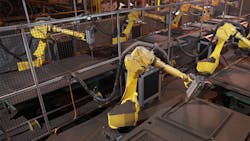Wisconsin’s Waukesha Foundry Inc. is celebrating its centennial year in 2012, noting a 100-year record of adapting its product line and adjusting its business strategy to address changing demand. The foundry established in 1912 was once a maker of cast aluminum cookware, and today it manufactures high-alloy ferrous castings for tooling and components used in aerospace, automotive, and defense markets, petrochemical processing, and food processing equipment manufacturing.
On September 8, the company will celebrate its anniversary with an open house and picnic for employees and their families, retirees, and Waukesha-area dignitaries.
Corwin C. (“C.C.”) Smith established Waukesha Foundry in 1912, originally to produce brass castings. By 1915 it had introduced nickel products because Smith saw a rising demand from food processors for parts made of ‘non-galling’ alloys that would improve process sanitation. By the mid 1930s, Waukesha Foundry was the U.S.’s largest producer of nickel-alloy castings.
During the Great Depression Waukesha Foundry started producing cast aluminum cookware. Next, a line pump products was introduced and by 1940 the metalcaster counted as its customers the food processing, chemicals, oil, cosmetics, and pharmaceuticals industries. An R&D lab was added in 1940, followed by a metallurgical lab in 1942. Both of these operations became part of Waukesha Foundry’s strategy to develop new products and alloys, specifically in stainless steel, a market segment that grew in demand during the 1950s.
While the foundry’s ownership changed hands over the century, Waukesha Foundry continued to expand. Today, Milwaukee-based Facilitator Capital, FCF Partners, owns the company.
“2012 has been an exciting year for Waukesha Foundry,” explained president and CEO Ken Kurek.
“We are celebrating our past while making a major investment in our future,” he said, describing a $2.2-million capital investment in foundry equipment and office renovation.
Other developments during the centennial year have been a restructured labor agreement with the United Steelworkers union, including a new Pay-for-Skill program; a technology-sharing partnership with France’s Groupe Allio, a toolmaker; an important new order from Japan Aeroforge and Kobe Steel Ltd.; and the launch of a $25,000 scholarship program for students enrolled at the Univ. of Wisconsin-Milwaukee College of Engineering & Applied Science.
Just as notable, the foundry is pursuing an aggressive growth strategy that has resulted in a 40% increase in sales since 2010. Kurek pointed out the similarities between the early era of Waukesha Foundry and today’s business: “The company was always proud to be on the cutting edge of technology for its time.”
About the Author
Robert Brooks
Content Director
Robert Brooks has been a business-to-business reporter, writer, editor, and columnist for more than 20 years, specializing in the primary metal and basic manufacturing industries. His work has covered a wide range of topics, including process technology, resource development, material selection, product design, workforce development, and industrial market strategies, among others.
